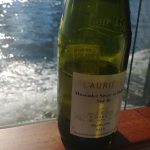
Looking out over the Hudson River you might have seen a streak of pink on select spring days courtesy of the annual La Nuit en Rose’ extravaganza. But on this particular afternoon, there was not only rose’ on the water, but red and whites as well during the Loire Valley’s debut wine cruise around New York City. Given the Loire Valley’s international reputation for making crisp and refreshing wines with fruit driven character it was not surprising to find that the 8 Loire Valley wines that were poured proved a perfect match for not only the 8 regionally and locally sourced bites that were paired with them, but the season as well.

When it comes to wine diversity few areas can rival that of the Loire Valley. Given the Loire Valley’s variation in soil type depending on the subarea — from granite in the Pays Nantais, to slate and sandstone in the Anjou — not to mention the microclimates conducive to wine production — ocean air, mild winters, and hot and humid, or moderate summers again depending on the subarea — it is no wonder that the Loire Valley has enjoyed a two thousand year-old history of winemaking and counting.
The four regions that comprise the Loire Valley boast fifty one appellations and denominations, four PGIs ((Protected Geographical Indication) that ensures both the quality and the provenance of the grape used in the production of the wine), 24 varietals, including Pinot Noir, Cabernet Franc, Chenin Blanc, Melon de Bourgogne and Sauvignon Blanc, and almost sixty thousand hectares of vineyards.
One of the things about Loire Valley wines that makes them so appealing not only especially during the warmer months but also as a complement for a wide range of foods from lightly seasoned poultry and seafood, to spicier offerings, is its inherent acidity. Loire Valley wines, best when served chilled, enliven the palate (not to mention sooth it when things heat up).

A 2017 Menetou Salon Blanc, Domaine de Champarlan with bright notes of lemon and green apple, some salinity, pronounced acidity, and a clean finish, was paired with a tomato bruschetta drizzled with olive oil. This classic Loire Valley white worked well with the naturally sweet vine ripened tomatoes.

A 2017 Muscadet, Domaine de L Auriere followed a raw oyster drizzled with lemon. The Muscadet, with its balanced minerality, candied citrus fruit notes, subtle salinity and elements of slate and oyster shell was an apt choice to pair with this raw seafood delicacy. This area is prime territory for Muscadet production while the flavor attributes of the wine serve as a typical complement to uncooked and simply prepared seafood in these parts.

A 2017 Pouilly Fume’, Regis Minet ‘Vielles Vignes’ with bright citrus, peach and apricot notes, grassy undertones and refreshing acidity was served with a citrus seasoned chilled shrimp. The fruit driven and herbaceous character of this crisp wine combined seamlessly with the sweet and mildly tangy flavors of the shrimp.

A chilled 2016 Sancerre Rouge, Domaine Hippolyte characterized by juicy berry and dark fruit notes and fresh acidity was served with Windham cheese. This youthful chilled red from Sancerre, synonymous with quality Sauvignon Blanc was a pleasant surprise from an area usually recognized for its white wines. It could prove to be a great choice for red wine purists who can literally “chill” out with their glass of rouge even on a sweltering summer day.
A 2016 IGP Chardonnay, Domaine de la Fruitiere with lively ripe citrus fruit notes, hints of vanilla cream and subtle minerality came with a soft brioche. The creaminess of the wine, as well as its lime zest and orange character, enhanced the buttery aspects of the baked brioche.
A 2107 Saumur Rouge, Domaine Guiberteau was served with a roast beef baguette. The juicy grape skin dominant character of this wine, characterized by juicy cherry, plum and blackberry notes, and grassy and herbaceous elements, was a fine complement to the mild smokiness of the roast beef.

A Cremant de Loire, Chateau Langlois was paired with a frozen yogurt. This sparkling wine, characterized by soft lemon and green apple notes and persistent bubbles enhanced the slightly sweet and tart aspects of this creamy dessert. The Loire Valley is second only to Champagne in terms of sparkling wine production by volume, and if this Cremant is any indication of the quality of Loire Valley sparkling wines (Cremant is produced using the Methode Traditionelle, the same process used to make Champagne), I hope they continue to ramp up production.

A 2018 Rose’ de Loire, Chateau Soucherie was complemented by a ripe strawberry. The pairing of this wine’s grape skin dominant profile, characterized by fresh red berry notes and soft acidity, enhanced the juicy fruit elements of the ripe strawberry. The color coordination was a nice touch as well.

Be First to Comment